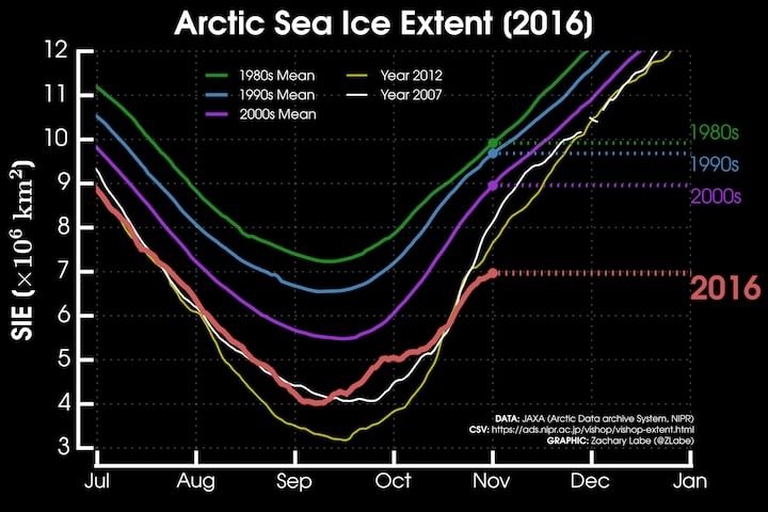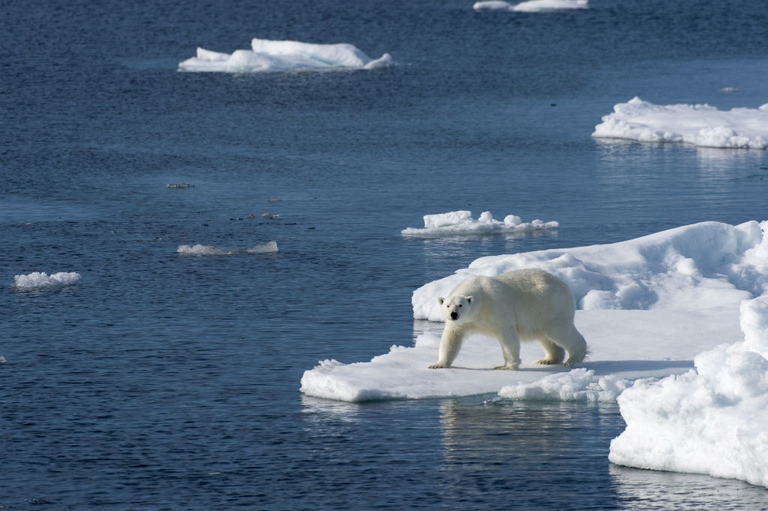
The 26th edition of the United Nations Climate Change Conference, COP26, will be held in Glasgow, Scotland in November 2020. The pre-COP will take place in Milan, Italy.
Alarming data come from the Arctic Circle. Abnormal temperatures and near-record low sea ice coverage. Experts warn: “Lost ice can’t recover”.
There should be more ice, a lot more ice. And temperatures should be below zero degrees Celsius. But this isn’t the case. According to researchers from the Danish Meteorological Institute and Rutgers University, who monitor temperatures and sea ice cover above the 80th parallel, temperatures in the Arctic are only -5°C, when they should be -25°C.
In some areas of the Polar Circle recorded air temperatures are 20°C warmer than normal, while sea temperatures are nearly 4°C higher than usual. “In October and November Arctic sea ice was at the lowest extent ever recorded”, says Elisa Palazzi, researcher at the Institute of Atmospheric Science and Climate (ISAC) of the Italian Research Council (CNR). “This is a problem because such a situation makes it difficult for new ice to form. And the ice that forms is thinner and thinner”.
Scientists are surprised by these anomalies that reinforce the negative trend of the last few years. Data collected in October by the National Snow and Ice Data Center (NSIDC) indicates that Arctic sea ice extent at the end of September stood at another low, 4.72 million square kilometres. It has declined at a rate of 13.3 per cent every ten years. “The reduction of sea ice cover influences how much sunlight is absorbed, which heats up sea waters”, Palazzi added. “It is a well-known feedback mechanism, a self-feeding cycle. The less ice there is, the larger the potential warming influence. That’s why the Arctic Pole is a sentinel of climate change”.
Today’s latest #Arctic mean temperature continues to move the wrong direction… up. Quite an anomalous spike! pic.twitter.com/C93cQWUKV9
— Zack Labe (@ZLabe) 15 novembre 2016
According to Nasa, the Arctic Ocean should reach its maximum yearly extent between February and April but on 24 March 2016 it “peaked at 14.52 million square kilometers, a new record low winter maximum extent in the satellite record that started in 1979”. Nasa points out that in the last 13 years growing sea ice extent lows have been recorded constantly. “It is an exceptional phenomenon that follows an expected trend. In the past 25 years sea ice lost 30 per cent of its extent”.
“This is an alarming phenomenon”, the CNR researcher said. “If we consider the most optimistic climate models, we could expect the trend to reach a plateau. But the ice lost up to this point can’t be recovered”. The warning signals from the North of the planet are increasingly alarming.
Siamo anche su WhatsApp. Segui il canale ufficiale LifeGate per restare aggiornata, aggiornato sulle ultime notizie e sulle nostre attività.
![]()
Quest'opera è distribuita con Licenza Creative Commons Attribuzione - Non commerciale - Non opere derivate 4.0 Internazionale.
The 26th edition of the United Nations Climate Change Conference, COP26, will be held in Glasgow, Scotland in November 2020. The pre-COP will take place in Milan, Italy.
Thanks to activists, the voice of the world’s peoples resounded through the COP25 like an alarm bell. Governments didn’t reach the results they demanded, but their cries and messages were stronger than ever, reaching even those who weren’t in Madrid.
Climate change poses a risk for millions. However, women are the most vulnerable to its negative consequences: a few simple considerations by the Italian Climate Network help us perceive the global implications of this.
The COP25 ended two days late and with very few steps ahead made. Climate negotiations in 2020 will be an uphill battle as political will clearly seems to be lacking, once again.
The last ten years have been the most “exceptional” and hottest decade ever, with extreme weather hitting people and ecosystems harder and more frequently. 2019 is also on course to becoming the second or third hottest year since records began.
Unite Behind the Science: this was the title of the conference held at the COP25 on 10 December. Greta Thunberg’s presence filled the arena, but this time it was scientists’ turn to speak.
25,000 delegates meet for the COP25 from 2 to 13 December. What can we hope this UN climate change conference, whose venue was changed from Santiago de Chile to Madrid, will achieve?
100 eminent people from all over the world, including Vandana Shiva, Naomi Klein and Noam Chomsky, have signed an open letter after the disappointing results of the COP24. A call-to-arms for climate against world leaders’ indifference.
The outcome of the COP24 in Katowice left many unsatisfied. Greta Thunberg, a young Swedish environmental activist, gave a harsh, heartfelt speech addressing world leaders.









